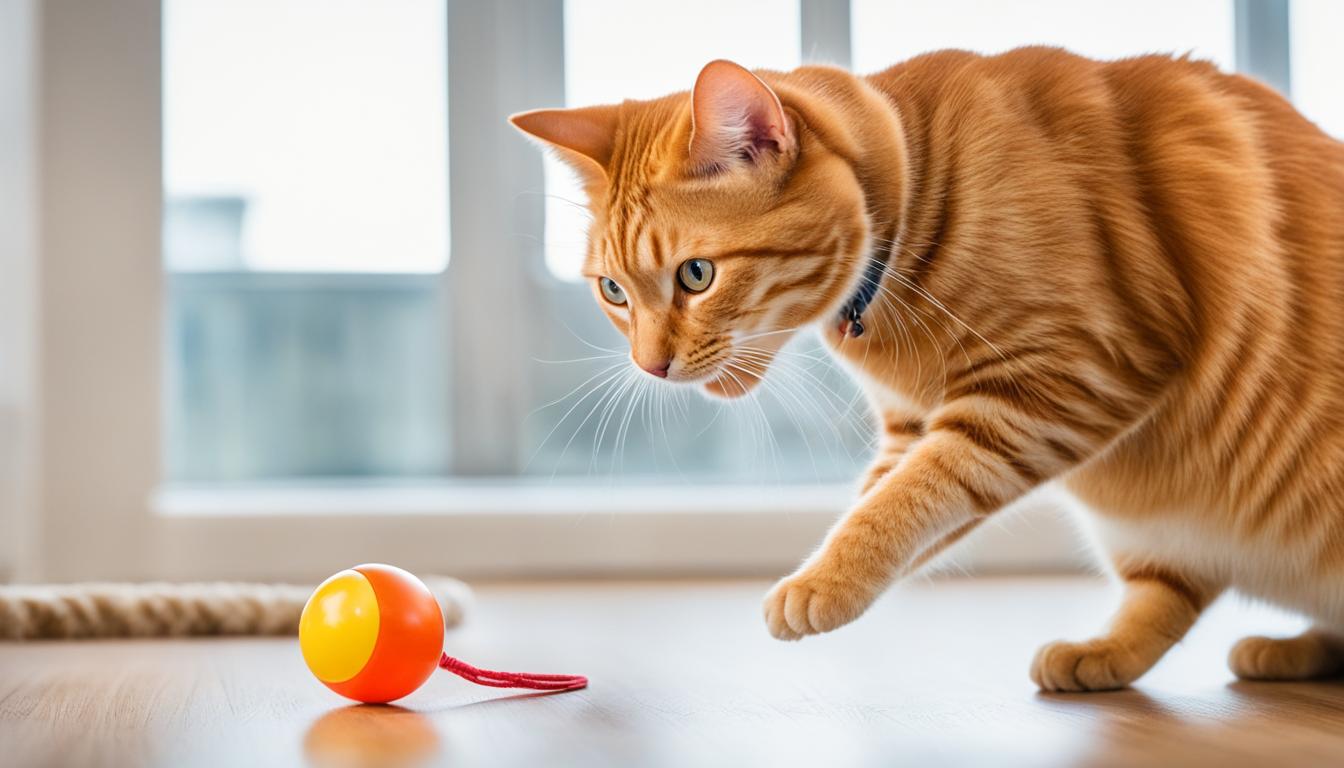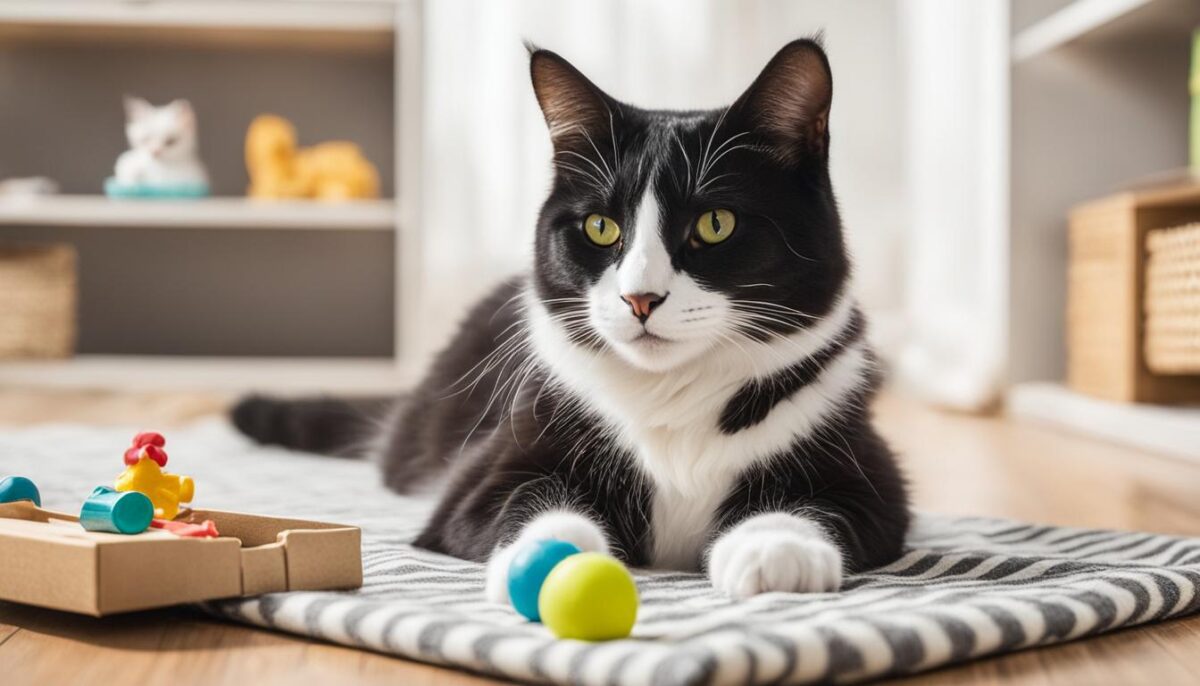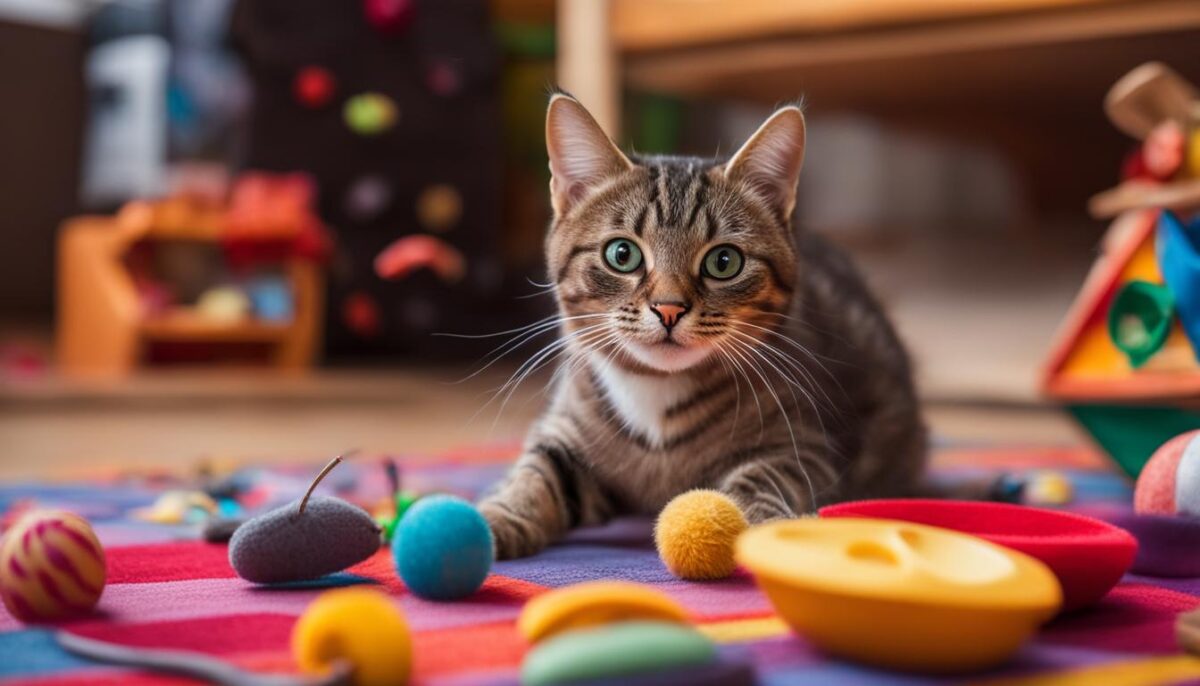Hey there! Have you ever wished to understand your fluffy buddy better? Guess what, you can help your cat learn cool things and care for them with fun training! Training is not just for dogs. Your cat can learn things too and it helps them stay sharp. Plus, playing these learning games helps you both get closer.
Think of cat training like a game that makes your cat happy and helps stop naughty habits, like scratching the couch. Your cat can learn to listen to you, which is pretty neat, and it’s a sweet way to make sure they’re having a good time and staying out of trouble.
Key Takeaways
- Training your cat is a great way to bond.
- Learning tricks keeps your cat’s brain busy.
- Teaching your cat can shape good behavior in fun ways.
- Playing training games helps your cat listen to you.
- Cat care includes teaching them cool new things.
Understanding Your Cat’s Behavior for Effective Training
Hey there, cat lovers! Let’s dive into what makes your whiskered friend tick. By getting the scoop on how cats behave, you can teach them new things in a way that’s fun for both of you. It’s like figuring out a secret code to make your time together even better!
The Importance of Mental Stimulation in Cats
Cats are smart, and they need exciting things to do. Like a treasure hunt, activities that make them think and play keep them happy. When cats get to act like the little hunters they are, it means less trouble and more purrs!
Recognizing Natural Instincts and Using Them in Training
Your kitty has special skills, like being curious and loving to explore. You can use these natural talents when you train them. It’s like turning their favorite game into a learning adventure!
Learning to Read Your Cat’s Body Language
Cats talk with their tails, ears, and whiskers. Once you learn their secret signals, you’ll know just how they feel. It’s like they’re telling you a story without saying a word. Keep an eye out for a happy tail or careful ears, and you’ll both enjoy training time even more!
Check out this table to see some cool cat moves and what they mean. It’s like a fun puzzle to learn with your furry buddy!
| Move | What It Means |
|---|---|
| Ears Up | Listening and interested |
| Ears Flat | Scared or annoyed |
| Slow Blink | Trust and love |
| Puffed Tail | Surprised or scared |
| Rubbing Against You | Feeling friendly |
| Kneading | Super comfy and happy |
Key Principles of Positive Reinforcement
When you’re training your furry friend, there’s a secret to helping them learn faster. It’s called positive reinforcement. This means you reward them with yummy training treats or sweet praises when they do something good. Your cat then thinks, “Hey, I like this!” and they’ll want to do that good thing again and again. It’s like when you get a gold star for a job well done. You feel happy and are excited to try more, right? That’s how your cat feels with positive reinforcement. Shall we learn the best ways to do it?
How to Use Treats and Praises to Encourage Desired Behaviors
Let’s say you want your cat to sit. When they finally plop down, you give them a treat right away and say “Good job!” This helps your cat understand that sitting equals tasty snacks and happy words from you. They learn that this desirable behavior gets them good things!
Timing Your Rewards for Maximum Effect
Guess what? Cats are super smart, but they need to know exactly what they did well. So, if your kitty sits, give them that treat super fast. Don’t wait! This quick timing helps your cat connect sitting with getting a reward. If you wait too long, they might not remember what they did to get the treat.
Consistency and Patience in Cat Training
Training isn’t just a one-time thing. It’s important to keep practicing with your cat. Always use the same words and the same yummy treats. This makes it easier for your cat to understand what you want. And remember, be patient. Training takes time, and every kitty learns at their own pace.
Essential Tools for Training Your Feline Friend
Training your cat is like playing a fun game where you both win. To start, you’ll need some cat training tools. Imagine you’re a magician and your magic wand is a small tool called a clicker. With clicker training, every time your cat does something great, you click and give them a yummy training treat.
Let’s look at a table to see what tools can help you teach your cat cool tricks:
| Training Tool | Why It’s Great | How To Use It |
|---|---|---|
| Clicker | Makes a special sound your cat will learn to love | Click right when your cat does the trick, then quickly give a treat |
| Training Treats | Tasty snacks make training a delicious game | Give a treat after the click to reward good behavior |
| Toy Mouse | Sets up fun practice for your cat’s natural hunting games | Use it to teach ‘fetch’ or ‘chase’ and make training active |
Now, with your clicker, treats, and toys, you’re all set to teach your cat amazing things. Have fun, be patient, and enjoy the special time with your furry friend!
Cat Training Tips and Tricks
Teaching your cat can be a fun way to play and learn together! You might think cats do what they want, but with yummy treats and patience, they can learn cool tricks. Let’s look at some easy ways to teach your cat and make playtime smarter!
Step-by-Step Guide to Teaching the ‘Sit’ Command
Start by getting some small treats that your cat loves. Hold one treat close to your cat’s nose, and then slowly move it over their head. As their eyes follow the treat, their bottom should naturally go down. When their bottom touches the ground, say “sit” and give them the treat. Good job!
Training Your Cat to Respond to Their Name
When your cat looks at you, say their name and give them a treat. Do this a few times every day, and soon they’ll come when you call. It’s like a game of ‘look at me’ that helps them learn who they are!
Interactive Play and Tricks to Build Intelligence
Cats are smart, and playing games helps them get even smarter! You can use toys to teach them to jump or twirl. Every time your cat does the trick, they get a treat. This kind of play makes learning fun and grows your cat’s smarts.
| Trick | How to Do It | Treats Needed |
|---|---|---|
| Sit | Move treat over head | 1-2 |
| Name Response | Call and reward when they look | 1 each time |
| Jump | Lure over a stick or toy | 1-2 |
Handling Common Feline Behavioral Issues
When your cat shows tricky behaviors like scratching, biting, or counter surfing, don’t worry! There are simple ways to teach them better habits. It’s like learning a new game, where your cat can become a star player with just a little practice.
- Does your cat think the couch is a great place to sharpen their claws? Try this game: Show them a scratching post covered in fun stuff like catnip or dangling toys, making it the most interesting spot in the room!
- What about those surprise nibbles on your fingers? If you’re playing and they start biting, pause the game. Offer them a soft toy or a yummy treat to lick instead. This teaches them that toys and treats are for biting, not you.
- And those kitchen counters adventures? They’re not for our furry friends. Set up a little booby trap with sticky tape that’s not so comfy on their paws. They’ll decide that the floor is a much better place to be.
Remember, playing this new game with your cat every day will help them remember the new rules. Stay kind and patient, and you’ll both win!
Conclusion
By now, you’ve seen how teaching your cat can be so much more than just getting them to do cool tricks. It’s all about creating a special link between you and your furry pal. Think of it like a friendship bracelet that keeps getting more colors. Every time you and your cat learn something new together, it’s like adding another bright thread to that bracelet.
Reaping the Benefits of a Well-Trained Cat
Imagine having a pet that listens to you, respects your space, and knows how to make living together a bunch of fun. That’s the magic of cat training! You’ll notice your home is more peaceful, and your bond with your cat is stronger. Plus, your cat will be super happy because their brain is getting a good workout, and they understand you better. The benefits of cat training shine bright in every meow and purr, making every day together even more awesome.
Continued Learning and Bonding with Your Cat
Now, don’t stop there! Learning with your cat is a never-ending adventure. Keep exploring, playing, and growing together. Every little step you both take is a big leap in becoming the best of friends. It’s about lifelong learning and bonding with pets. So enjoy each little win, give a gentle pat for a job well done, and look forward to all the amazing moments you’ll share. After all, the friendship you have with your cat is one of the coolest parts of life!
FAQ
What Are the Benefits of Training My Cat?
Training your cat offers numerous benefits, such as improving their behavior, providing mental stimulation, and strengthening the bond between you and your pet. It also helps to prevent unwanted behaviors like scratching furniture and can make your interactions with your cat more enjoyable and fulfilling.
How Can I Understand My Cat’s Behavior to Train Them Effectively?
Understanding your cat’s behavior is vital for effective training. Pay attention to their natural instincts, like the urge to hunt, and offer mental stimulation to prevent boredom. Observing and interpreting your cat’s body language will also help you to tailor your training methods to their mood and ensure that training is a positive experience for your cat.
Why Is Positive Reinforcement Important in Cat Training?
Positive reinforcement is key to successful cat training. Rewarding your cat with treats and praise encourages them to repeat desired behaviors. The prompt timing of rewards helps your cat associate the correct action with positive outcomes. Consistency and patience with this approach will lead to better results and maintain your cat’s interest in learning.
What Tools Do I Need for Training My Cat?
A few basic tools can be very effective for training your cat. Clickers are great for marking desired behavior, high-value training treats motivate your cat to participate, and hand gestures can be used as non-verbal cues. Combined, these tools help facilitate learning and allow you to communicate commands more effectively.
How Do I Teach My Cat Basic Commands?
To teach your cat basic commands like ‘sit’, use a treat to lure them into the position and introduce a verbal cue when they begin to understand the action. For teaching your cat to respond to their name, reward them whenever they look at you after you call. These simple steps can set the foundation for more advanced tricks later on.
How Can I Address Common Behavioral Issues in My Cat?
Address common behavioral issues by using specific training strategies. Use deterrents to keep cats off countertops, offer attractive alternatives for scratching, and avoid engaging in rough play to prevent biting. Consistent training techniques are crucial for mitigating these behaviors and creating a peaceful living environment.
What Do I Gain From Having a Well-Trained Cat?
Training your cat goes beyond modifying their behavior—it deepens the loving relationship you share. It provides your cat with structure and mental stimulation, which enhances their well-being. Training allows for clearer communication and instills positive habits, making life together more harmonious and enjoyable for both of you.
How Should I Continue Training and Bonding With My Cat?
Continue training and bonding with your cat through consistent practice, patience, and by constantly introducing new activities and challenges to keep them engaged. Celebrate every small success to encourage both you and your cat and remember that cat training is a continuous process that strengthens your connection over time.


